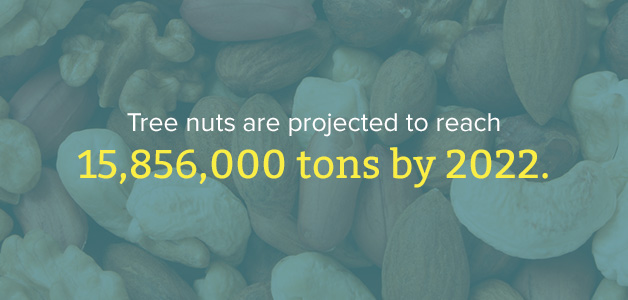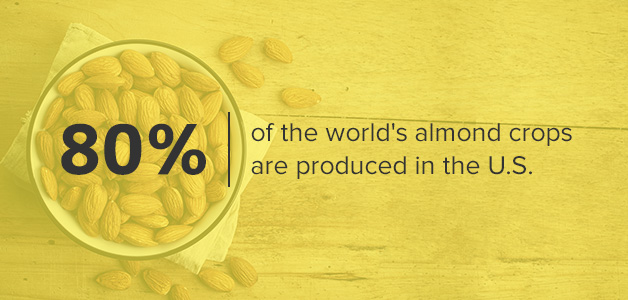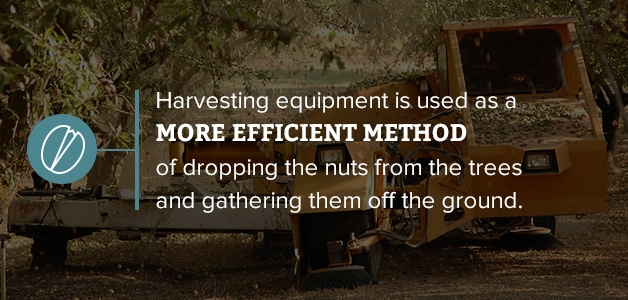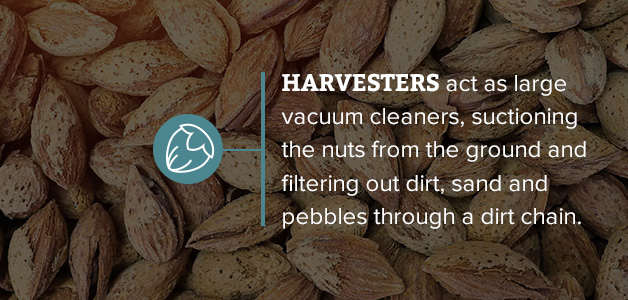The Nut Harvesting Industry & Harvesting Equipment Guide
Whether you're currently in the nut harvesting industry or want to try your hand at harvesting for the first time, there's no better time than now to start your nut harvesting journey.
A recent trend in health and dieting has boosted the popularity of nut eating. Consumers, growing increasingly conscious of their health and wellness, have noted the nutritional value nuts provide as a rich source of protein, fiber and fatty acids such as palmitoleic acids and omega-3. Medical studies have praised nuts' ability in reducing the risks of cancer and heart disease, and wellness magazines and blogs continue to promote the benefits of eating them. And the success of nut spreads such as Nutella and the rapid boom of the nut butter craze, at an80 percent rise from 2011, steadily builds demand for nut products.
Overall, nut harvesting is a rewarding choice.
Tree nuts, in particular, remain high in popularity and earnings. With demand tree nuts projected to reach 15,856,000 tons by 2022, it's both useful and profitable to enter into the tree nut harvesting industry.

But the proper equipment is necessary to make the most out of your tree nut crop. There are several types of machinery you'll need for the highest efficiency of your harvest, and you'll need to care for each machine responsibly. Various rubber parts on the harvesting machinery need to be continually monitored and, if needed, replaced.
Read on to learn more about the nut harvesting industry, the equipment you'll need to harvest your crop, the most common rubber parts of nut harvesting equipment and the signs you'll need to look for to make sure that all your machines' parts are working correctly.
About the Nut Harvesting Industry
The United States fruit and tree nut industry generates $25 million of farm cash receipts per year, accounting for 13 percent of cash receipts for all crops.
With the national health trends that were popularized in the last 10 years, tree nut production rose significantly. In 2012, the year of the most recent agricultural census, production totaled 2.7 million tons.8
California harvests 90 percent of this tree nut crop. The state's orchards account for nearly all almond, pistachio and walnut production. Its almond crop is expected to produce a record harvest during the 2017 to 2018 season.
Georgia, New Mexico and Texas now produce most of the country's pecan crop, which is also expected to rise.
Types of Nuts Harvested
Different kinds of nuts have different ideal climates and typical harvest times. Four types of tree nuts — almonds, pecans, walnuts and pistachios — account for nearly all tree nut acreage in the U.S.

1. Almonds
Almonds compose the largest acreage of all tree nuts planted in America today. The U.S. leads the world in almond production, harvesting 80 percent of the world's almond crops.
These tree nuts require a growth period of winter chilling but can't handle heavy frosts, so California's moderate climate provides the crop an ideal location. California grows nearly all of the country's almond crops.
Almonds continue to grow in per-person consumption, making them the number one type of tree nut. A popular choice for health enthusiasts, they provide a strong source of calcium and magnesium. Their massive success stems from their use in granola bars, cereals, chocolate snacks and baking goods.
A leathery green hull encases the almond and splits open when the almond is ripe. A crop is ready for harvest when most of the hulls have split and the almonds start falling to the ground, typically between August and October.
2. Walnuts
Both black and English walnuts are grown in the United States. They require a moderate climate with mild summers and little to no night frost. While generally found in California, they are also produced in Midwestern states such as Indiana, Illinois, Missouri and Iowa.
Walnuts are surrounded by a tough, round outer hull that turns from a bright green to a yellowish green as the nut ripens. Like almond harvesting, the walnut harvest begins when most of the hulls have split and the nuts start falling from the trees. Walnuts ripen between mid-September and early November.
3. Pistachios
Pistachios saw a 51 percent increase in acreage between 2007 and 2012, the most significant growth of all the top tree nuts. This increase is possibly due to heightened demand. Although tree nuts as a whole experienced a recent popularity boost, pistachios particularly enjoyed the increased attention of celebrity endorsements and worldwide trade.
Pistachios thrive in areas with hot summers and cool winters, with California again providing an ideal climate. Outside the U.S., they are primarily grown in the Middle East and Central Asia, where experts believe they originated.
These tree nuts typically grow in early summer and ripen for harvest between late August and September. When they're nearly ready for harvest, the small green hull begins to turn reddish-yellow. It then turns red and starts to separate from the inner shell when fully ripe. Because the shell splits open before harvest, pistachios cannot be harvested off the ground like other nuts, as this would run the risk of soil contamination.
4. Pecans
The only top four tree nut in America that isn't primarily grown in California, pecans thrive in the warm summers of Southern and Southwestern states. They predominately grow in Texas, Georgia, New Mexico, Arizona and Oklahoma, requiring short winters and long, hot summer climates.
Pecans grow inside a thin green husk that browns as the nut matures. The husk cracks open when ready for harvest, typically between late September and November.

How Nuts Are Harvested
When the nuts have matured and most of their hulls have cracked open, the nuts are ready for harvest.
While people owning only a few nut trees can simply pick nuts off the ground by hand, farmers with commercial nut crops have neither the time nor the manpower to pick up the nuts themselves. Harvesting equipment is used as a more efficient method of dropping the nuts from the trees and gathering them off the ground.
First, a mechanical shaker — a tractor-like vehicle with a big mechanical arm that holds a large claw — is driven up to a tree. The arm reaches out, and the claw grabs around the tree's trunk using a hydraulic cylinder. Then, at the press of a button, the machine begins to rapidly shake the tree using small vibrations. The vibrations loosen the remaining nuts, which causes them to fall to the ground.

After falling to the ground, the nuts are swept into rows using large sweepers and quickly sucked up with harvesting machinery. They are taken to a hulling facility, where the nuts are separated from the hulls and are then dried and prepared for storage or processing.
When harvesting pistachios, a catch frame is used to keep the nuts from hitting the ground. The nuts fall directly onto a conveyor, so there's no need to use a sweeper.
Types of Machines Used in Nut Harvesting
Three machines make up the majority of the nut harvesting process.
1. Tree Shakers
A tree shaker rocks the nuts off the tree and onto the ground with soft, rapid vibrations. Its creation marked a vital step in the ease and efficiency of nut harvesting, allowing farmers the speed to finish multiple trees in under a minute.
There are two main types of tree shakers available for farmers today:
- Tractor-mounted shakers are budget-friendly arm attachments that mount to an existing tractor's three-point linkage. The arm is then attached to the front or side of the tractor.
- Self-propelled shakers are the most popular option of tree shakers. These vehicles come equipped with their own motors and maneuvering systems that don't have to be hooked up to any other machine. The arm and claw come pre-attached either to the front or side of the shaker.
If you're growing pistachios or other nuts that cannot be shaken to the ground, you'll need a shaker with a collector — the large, flatbed that catches the nuts as they are shaken from the tree and drops them into a conveyor.
2. Nut Sweepers
Aside from pistachios, most nuts lay on the ground after being shaken off the tree. These nuts should be collected as soon as possible. For added efficiency, sweepers push the nuts into rows that make it easier for the harvesters to pick up as many of them as possible.
The sweepers are large, tractor-like vehicles with circular teeth and "sweepers" that collect the nuts while a fan blows them into piles.
3. Nut Harvesters
Once the nuts are collected into rows, they need to be picked up and taken to the hulling facility. Harvesters act as large vacuum cleaners, suctioning the nuts from the ground and filtering out dirt, sand and pebbles through a dirt chain. They empty the nuts into a cart, which connects to the harvester via a hydraulic hitch.
When the harvester is run, rubber fingers on the inside lift the nuts off the ground and towards a metal drum, which rotates in the machine. A fan then blows the leaves and other debris out the back, while a conveyor belt processes the nuts through the harvester.
You can buy either a self-propelled harvester or one that connects to a tractor for the right blend of power, control and efficiency.
Most Common Rubber Parts on Nut Harvesting Machines
While nut harvesting equipment is built to last for years, there are several rubber parts on tree shakers, sweepers and harvesters that need to be continually monitored for wear and tear. Some of these rubber parts include:
- Shaker pads: Attached to the shaker head you'll find oval or square pads. These pads grip the trunk and provide the stability and support necessary to vibrate the tree, as well as the cushioning needed to avoid hurting it.
- Harvester fingers: The fingers are the pieces of rubber inside the nut harvester that pick the nuts up off the ground and into the machine. Each harvester has hundreds of fingers that work together to pick up all the nuts.
- Sweeper paddles: The outside front of many nut sweepers features rubber paddle wheels. They prevent leaf and debris pile-up.
- Conveyor belt: The conveyor belt moves the nuts through the harvester and filters out dirt and pebbles from the nuts.
- Sweeper and harvester flaps: The fronts of most nut sweepers and harvesters have large rubber flaps that guide the nuts into the machine.
- Rubber hosing: Located throughout the machines, rubber hosing connects various parts of the engine.

How to Spot Faulty Rubber Parts on Your Machines
Your equipment goes through a lot. It's designed to handle outdoor elements and excessive vibrations. It protects your trees from harm while forcibly shaking the crop off of them. Your machines are a vital part of the nut harvesting process.
Because they're central to the success of your crop, it's essential that you monitor your machines for faulty parts. Particularly, the rubber parts that compose the shaker head and the inner parts of the harvester need to stay in top condition. If you see any signs of wear, contact your local rubber parts company to replace the old parts.
Here are some things you should look for when checking your machines:
- Missing pieces: There are hundreds of fingers in a harvester. These allow it to do its job at peak efficiency, but older parts can sometimes loosen when they can no longer handle heavy loads. Check the fingers after every harvest to ensure that none have broken off.
- Thinning pads: Like tires, other rubber parts will start to thin after years of wear. The large pads of the shaker heads are especially susceptible to deterioration, and worn-out pads could harm the trunks of your trees or provide less effective vibrations.
- Worn hoses: Sometimes rubber hoses can get worn away by debris or heavy use. Check the tubing throughout your machines and replace as necessary.
Smaller rubber parts may often go unnoticed. Check your owner's manual for service points that you should look at after using your machinery.
Rubber Replacement Parts for Agricultural Equipment
At Global EEE, we have over 50 years of customized rubber experience. Our expertise in crafting custom parts in the oil and agricultural industries makes us a brand you can trust. You can always count on Global EEE for quick turnaround and excellent customer care.
Our in-house design and engineering team is trained to provide quality custom agricultural products, so each rubber part is made to your machine's specific needs. We'll work with you to replace the worn-out rubber parts of your tree shakers, sweepers and harvesters including shaker head pads, conveyor belts, paddles and more.
Our team's ability to create high-quality rubber replacement parts for any agricultural equipment makes us a trusted provider to farming professionals in Bakersfield and the surrounding communities. We help people just like you find the right parts to make their harvesting equipment run smoothly. We promise to provide you with the parts you need for any new or used nut harvesting equipment at a reasonable price and with no defects.
When you order from Global EEE, you can be confident that you'll receive excellent service with results you can trust. We don't believe in outsourcing our products, because we value putting you first. We proudly offer replacement parts made in the U.S.
Contact us today for more information about how we can help you improve the quality of your nut harvesting equipment by updating its rubber parts. Tell us about your replacement part needs, and we'll give you a custom quote on our top-of-the-line rubber products.




